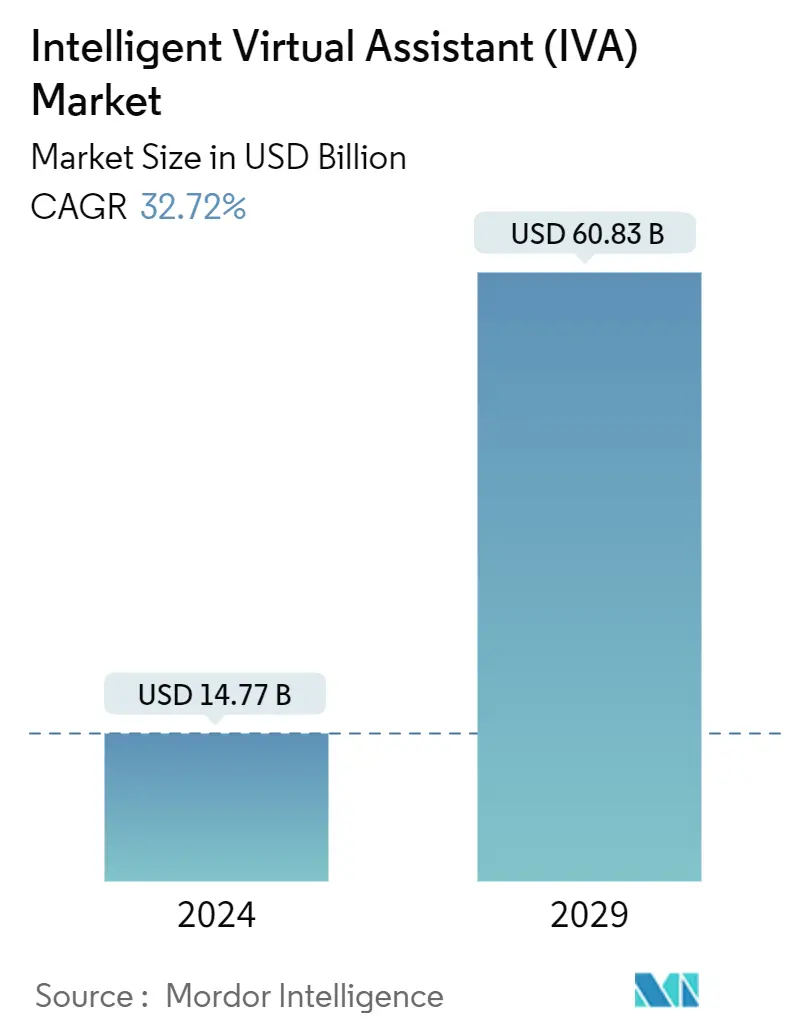Market Size of Intelligent Virtual Assistant (IVA) Industry

| Study Period | 2019 - 2029 |
| Market Size (2024) | USD 14.77 Billion |
| Market Size (2029) | USD 60.83 Billion |
| CAGR (2024 - 2029) | 32.72 % |
| Fastest Growing Market | Asia-Pacific |
| Largest Market | North America |
Major Players
*Disclaimer: Major Players sorted in no particular order |
Intelligent Virtual Assistant (IVA) Market Analysis
The Intelligent Virtual Assistant Market size is estimated at USD 14.77 billion in 2024, and is expected to reach USD 60.83 billion by 2029, growing at a CAGR of 32.72% during the forecast period (2024-2029).
- Deep neural networks, machine learning, and other advances in AI are making more virtual assistants possible. Chatbots and smart speakers are two examples of virtual assistants that are used in retail, BFSI, and healthcare, among other end-user industries. A virtual assistant acting as a personal assistant is a significant consumer-facing form. With the aid of Apple's Siri or by providing an easy-to-use interface for connected homes or autos, it aids users in completing various chores.
- Another use on the rise is virtual assistants adopting the customer service agent role. For enterprises, virtual assistants improve customer and brand experiences with a more consumer-friendly approach. For example, Five9, a cloud contact center provider, launched Five9 Virtual Assistant in partnership with Inference Solutions. The system leverages conversational artificial intelligence to automate manual tasks and answer common questions in the contact center.
- The capabilities of these assistants can also be changed based on the end user, which makes the customer experience better in a certain industry.For example, in the healthcare industry, a virtual assistant can help a customer find a doctor's office, fill and refill a prescription, and get payment reminders.
- Some virtual personal assistants that have gained recognition across the healthcare sector are Apple's Siri, Microsoft's Cortana, and Google's Assistant. Small and medium-sized businesses also drive the technology behind intelligent virtual assistants, making them important parts of health-intelligent virtual assistants. For example, Next IT's Alme of Healthcare is a virtual assistant that focuses on managing chronic diseases and actively answers patients' questions and requests. This is currently being adopted on a massive scale by healthcare providers.
- Aside from healthcare, retail companies also use chatbots in popular messaging apps to give their customers a better experience.Domino's and other stores use AI and machine learning to power virtual assistants like chatbots, which let customers place orders directly through Facebook Messenger.
- The Spring 2020 Smart Audio Report confirmed that the COVID-19 outbreak caused about 77% of US adults to change their normal routines. During these changes, more people used voice assistants, which was good for market growth.
- Companies are also rolling out offerings that help people stay aware of these uncertain times. For example, Avaamo, a deep-learning software company that specializes in conversational interfaces and is backed by Wipro Ventures, launched Project COVID, a COVID-19 Intelligent Virtual Assistant that can be used by anyone and helps find answers quickly in plain English.
Intelligent Virtual Assistant (IVA) Industry Segmentation
An intelligent virtual assistant is a computer system that uses artificial intelligence (AI) to act like a person and do tasks like customer service.This technology uses parts of IVR and other modern artificial intelligence projects to give users full-fledged virtual identities that can talk with them.
The Intelligent Virtual Assistant (IVA) Market is segmented by Product (Chatbot, Smart Speaker), User Interface (Text-to-Text, Text-to-Speech, Automatic Speech Recognition), End User (For Chatbots (Retail, Healthcare, BFSI, Telecom, Travel and Hospitality), For Smart Speaker (Personal and Commercial)), and Geography.
The market sizes and forecasts are provided in terms of value (USD) for all the above segments.
| By Product | |
| Chatbots | |
| Smart Speakers |
| By User Interface | |
| Text-to-Text | |
| Text-to-Speech | |
| Automatic Speech Recognition |
| By End-User | ||||||||
| ||||||||
|
| Geography | |||||||
| |||||||
| |||||||
| |||||||
| |||||||
|
Intelligent Virtual Assistant (IVA) Market Size Summary
The intelligent virtual assistant market is experiencing significant growth, driven by advancements in artificial intelligence technologies such as deep neural networks and machine learning. These technologies are enabling the development of more sophisticated virtual assistants, which are increasingly being integrated into various industries, including retail, banking, financial services, insurance, and healthcare. Virtual assistants are being utilized in diverse forms, from personal assistants like Apple's Siri to customer service agents that enhance brand experiences. The healthcare sector, in particular, is seeing a surge in the adoption of virtual assistants to manage patient interactions and streamline processes, while retail companies are leveraging chatbots to improve customer engagement through popular messaging platforms.
The market is characterized by a competitive landscape with several key players dominating the scene, although new entrants are emerging due to advancements in integrated speech and gesture recognition technologies. The demand for smart speakers, such as Amazon Echo and Google Nest, is also contributing to market expansion, as these devices become integral to connected lifestyles. The COVID-19 pandemic has further accelerated the adoption of voice assistants, as more consumers turned to these technologies for convenience and efficiency. Companies are continuously innovating, with recent developments including partnerships and new product launches aimed at enhancing the capabilities and integration of virtual assistants across various platforms and industries.
Intelligent Virtual Assistant (IVA) Market Size - Table of Contents
-
1. MARKET INSIGHTS
-
1.1 Market Overview
-
1.2 Industry Stakeholder Analysis
-
1.3 Industry Attractiveness - Porter's Five Forces Analysis
-
1.3.1 Bargaining Power of Suppliers
-
1.3.2 Bargaining Power of Consumers
-
1.3.3 Threat of New Entrants
-
1.3.4 Threat of Substitute Products
-
1.3.5 Intensity of Competitive Rivalry
-
-
1.4 Industry Value Chain Analysis
-
1.5 Technology Snapshot
-
1.6 Assessment of COVID-19 Impact on the Intelligent Virtual Assistant (IVA) Market
-
-
2. MARKET SEGMENTATION
-
2.1 By Product
-
2.1.1 Chatbots
-
2.1.2 Smart Speakers
-
-
2.2 By User Interface
-
2.2.1 Text-to-Text
-
2.2.2 Text-to-Speech
-
2.2.3 Automatic Speech Recognition
-
-
2.3 By End-User
-
2.3.1 Chatbots
-
2.3.1.1 Retail
-
2.3.1.2 BFSI
-
2.3.1.3 Healthcare
-
2.3.1.4 Telecom
-
2.3.1.5 Travel and Hospitality
-
2.3.1.6 Other End-User Industries
-
-
2.3.2 Smart Speakers
-
2.3.2.1 Personal
-
2.3.2.2 Commercial
-
-
-
2.4 Geography
-
2.4.1 North America
-
2.4.1.1 United States
-
2.4.1.2 Canada
-
-
2.4.2 Europe
-
2.4.2.1 Germany
-
2.4.2.2 United Kingdom
-
2.4.2.3 France
-
2.4.2.4 Spain
-
2.4.2.5 Rest of Europe
-
-
2.4.3 Asia-Pacific
-
2.4.3.1 China
-
2.4.3.2 Japan
-
2.4.3.3 India
-
2.4.3.4 Rest of Asia-Pacific
-
-
2.4.4 Latin America
-
2.4.4.1 Brazil
-
2.4.4.2 Argentina
-
2.4.4.3 Rest of Latin America
-
-
2.4.5 Middle East and Africa
-
2.4.5.1 UAE
-
2.4.5.2 Saudi Arabia
-
2.4.5.3 South Africa
-
2.4.5.4 Rest of Middle East and Africa
-
-
-
Intelligent Virtual Assistant (IVA) Market Size FAQs
How big is the Intelligent Virtual Assistant (IVA) Market?
The Intelligent Virtual Assistant (IVA) Market size is expected to reach USD 14.77 billion in 2024 and grow at a CAGR of 32.72% to reach USD 60.83 billion by 2029.
What is the current Intelligent Virtual Assistant (IVA) Market size?
In 2024, the Intelligent Virtual Assistant (IVA) Market size is expected to reach USD 14.77 billion.

